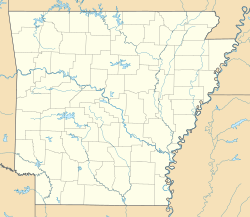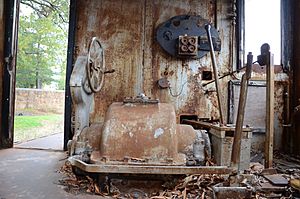Maumelle Ordnance Works Locomotive 1 facts for kids
Quick facts for kids Maumelle Ordnance Works Locomotive 1 |
||
| [[Image:Maumelle Ordnance Works Locomotive 1, Right Side.JPG | alt=]] | |
| Power type | Gasoline-mechanical | |
|---|---|---|
| References: | ||
| Builder | Vulcan Iron Works (of Wilkes-Barre, Pennsylvania) | |
| Serial number | 4364 | |
| Model | 35 ton | |
| Build date | April 1942 | |
| Configuration | 0-4-0 | |
| AAR wheel arr. | B | |
| UIC classification | B | |
| Gauge | 4 ft 8 1⁄2 in (1,435 mm) | |
| Locomotive weight | 35 short tons (32 t) | |
| Prime mover | Hercules, gasoline | |
| Engine RPM range | 1800 | |
| Transmission | 4-speed constant mesh, via side rods | |
| Delivered | 1942 | |
| Last run | c. 1958 | |
| Current owner | Fort Smith Trolley Museum (1988) | |
| Disposition | ||
|
Maumelle Ordnance Works Locomotive #1
|
||
| Location | 100 S 4th St., Fort Smith, Arkansas | |
| Area | less than one acre | |
| Built | 1942 | |
| Architect | Vulcan Iron Works | |
| NRHP reference No. | 06000835 | |
| Added to NRHP | September 20, 2006 | |
The Maumelle Ordnance Works Locomotive 1 is a special train engine. It runs on gasoline and uses gears, not electricity, to move. This two-axle railway locomotive was built in 1942 by a company called Vulcan Iron Works. The U.S. War Department bought it for a factory called Maumelle Ordnance Works. Today, it's a historic item. It was added to the U.S. National Register of Historic Places in 2006. You can see it preserved at the Fort Smith Trolley Museum.
History of the Maumelle Locomotive
The Maumelle Ordnance Works was a factory built in 1941. It was set up by the War Department to make explosives for World War II. These explosives included picric acid and ammonium nitrate.
The factory started making things in 1942. This locomotive was bought to move freight cars around the huge facility. The factory was spread out over 7,000 acres (2,800 ha). This large area helped keep things safe. If one part of the factory had an accident, it would not easily spread to other areas.
The factory stopped making explosives in August 1945. It was then cleaned up and closed down by November of that year. The land where the factory stood was later used to build the community of Maumelle, Arkansas.
After the war, Locomotive #1 was given to the Army. It was given a new number, 8223. It was then sent to the Newport Army Air Field. However, that airfield had already been given to the City of Newport.
In the early 1950s, the government sold the locomotive. It was bought by the Augusta Railroad. This was a small train line, only 1.65-mile (2.66 km) long. It connected Augusta, Arkansas, to the main Missouri Pacific Railroad line.
The little gasoline locomotive replaced an older steam engine from 1924. During the 1950s, the Augusta Railroad slowly stopped running. More and more goods were being moved by trucks instead of trains. The railroad officially closed in 1958.
Later, the locomotive was bought by Glenn Taggart and Bing Miller. Tommy Taggart then bought Miller's share. He kept the locomotive until June 1988. That's when he donated it to the Fort Smith Trolley Museum.
How the Locomotive Was Designed
Locomotive #1 has a very interesting design. Most modern train engines that don't use steam are diesel-electrics. This means a diesel engine creates electricity, which then powers electric motors to move the train. Some also use diesel-mechanical or diesel-hydraulic systems.
However, Locomotive 1 is different. It uses a gasoline engine and a mechanical gearbox. By the mid-1930s, most big train makers had stopped using gasoline engines. They preferred diesel engines because they used less fuel.
Vulcan Iron Works, the company that built this locomotive, still made a few gasoline engines. In early 1942, during World War II, it was probably easier to get a gasoline engine. They used less material, especially copper, which was very important for the war effort.
Using a mechanical gearbox for a train engine is also unusual. Train engines need to handle changing loads all the time. This makes it hard for a mechanical gearbox to work well. Only very small locomotives, pulling a few cars on flat tracks, have successfully used gearboxes.
Locomotive 1 has a four-speed gearbox. This gearbox connects to a jackshaft under the cab. The jackshaft then uses side rods to turn the two driving wheels. The choice of mechanical drive was likely due to the war. Generators and electric motors need a lot of copper, which was in short supply.
A Vulcan ad from 1947 described their geared locomotives. It said they had a "distinctive four-speed, constant-mesh, spur-geared transmission." This allowed for "easy gear changes at relatively high speeds." The gears and shafts were made of strong steel. They also had special springs for a smooth ride. This helped prevent the train from derailing on rough tracks.
This locomotive was added to the National Register of Historic Places in 2006.




